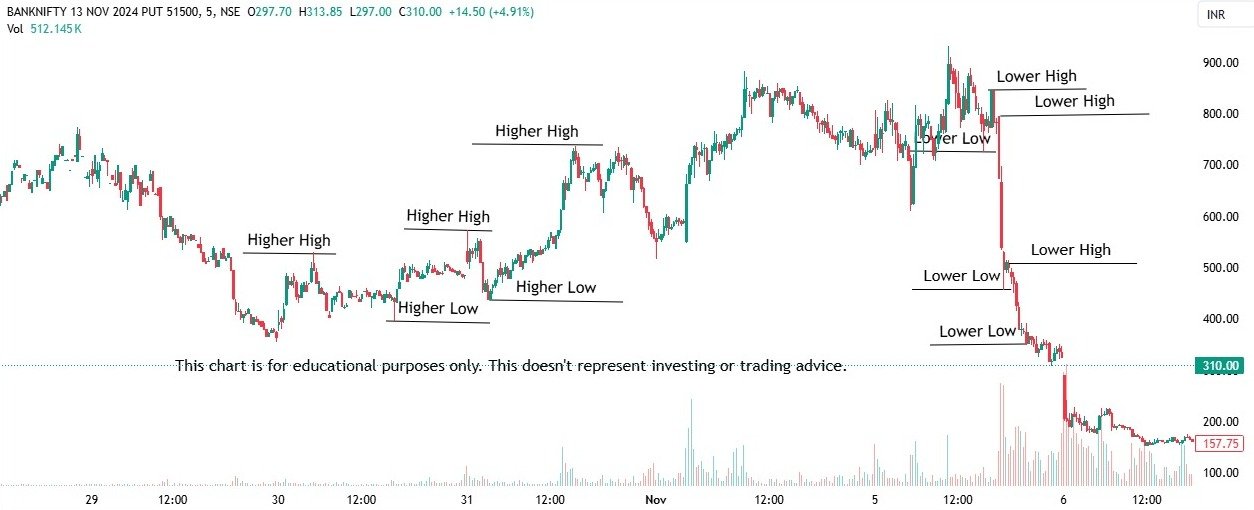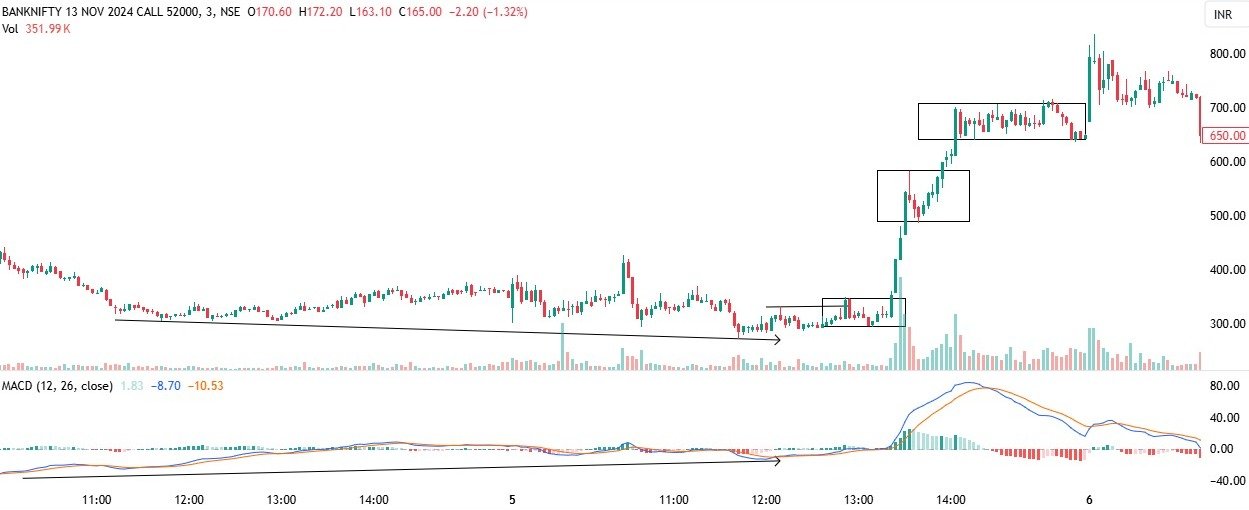The Darvas Box Strategy is a price-driven method used by traders to identify breakout or breakdown zones in the market, especially for Bank Nifty options. It involves constructing boxes around price levels and identifying the period’s top and lowest prices on options premium charts. This strategy is effective for index option scalpers due to its adaptability and risk management.
Applying Darvas Strategy to Bank Nifty Options for Maximum Gains
Are you patient enough to see your earnings grow? If so, let’s look at how the strong Darvas Box strategy may help you achieve consistent returns in options trading.
Given the inherent high volatility of options, especially in indices like the Nifty 50 and Bank Nifty, even minor price swings in the premium could potentially yield quick profit opportunities. For option buyers and sellers, Bank Nifty is the perfect setting because of its high volatility, which provides huge profit potential.
Using Nicolas Darvas’ simple yet powerful technique, you’ll realize that making money doesn’t need sophisticated theories or elaborate processes. Capitalize on momentum with discipline and a clear trading attitude with the Darvas Box strategy.
Not only does technique matter for options trading success, but so does self-discipline and understanding trading psychology. Learn how to use the Darvas Box to your advantage and see your wild actions pay off!
Price Action Patterns
Let’s get right into the options premium chart to analyze the price action patterns without adding unnecessary complications. Our objective is to work directly with options trading; thus, it’s better to study the options chart for price action.
For Bank Nifty, a highly liquid and volatile index, we may look at near-ATM (at-the-money) or OTM (out-of-the-money) options premiums. By evaluating these charts, we may learn about common market patterns, such as lower lows and lower highs in a downtrend or higher highs and higher lows in an uptrend.

BANKNIFTY 51500 PUT EXP 13 NOV’24 / 5 MIN
Bank Nifty options charts, like those for other markets, show predictable price fluctuations that reflect wider sentiment. When the Bank Nifty gains momentum, the options premiums react with obvious higher highs and higher lows, signaling an uptrend. In contrast, in a downtrend, premiums have lower highs and lower lows.
These price action patterns are crucial for applying the Darvas Box strategy in Bank Nifty options, as they help traders pinpoint entry and exit opportunities based on trend confirmation. By monitoring these trends, you can fine-tune your options trading strategy for intraday and scalping techniques.
Best Scalping Indicator
To be successful in options scalping, one needs a method for catching tiny price changes, which is particularly important when dealing with very liquid products like Bank Nifty. Based on principles of price action, the Darvas Box technique is an effective method that promotes trading upon the occurrence of new lows or highs.
By systematically noting the most recent highs and lows on a chart, the Darvas Box approach entails monitoring price movement in a systematic manner. When the market is going up, prices will rise to new heights, or higher highs. When prices continue to break higher highs, that’s when traders may start a long entry. To illustrate, traders may initiate a long position in a Bank Nifty option upon reaching a new high and set a stop-loss at the most recent higher low. Simple logic dictates that you should leave automatically if the price breaks below its previous low.
The Darvas Box approach reverses in a short entry situation: a position ends when the price fails to cross a prior high. For instance, if the market breaches a previous low, traders can establish a short position and set their stop-loss at the most recent lower high. By sticking to this structure, the technique assists traders in reducing risk by remaining in trades only while they keep their directional momentum. By adhering to these entry and exit points based on Darvas boxes, Bank Nifty option scalpers can profit from unpredictable markets without taking unnecessary risks.
Darvas Box Strategy for Options
Traders using the Darvas Box Strategy, a price-driven method, assemble boxes around price levels to help them choose when to enter and exit the market. If you’re a trader of options and you’re using Bank Nifty options in particular, this method may help you pinpoint potential breakout or breakdown zones in the market, which is ideal for scalping. For instance, traders may construct a Darvas Box by identifying the period’s top and lowest prices on options premium charts.
A breakout of the option’s premium above this box indicates an option buy. When the premium price moves out of the box, it’s a solid signal to enter the market with a stop-loss order at the prior low. Index (Nifty, Bank Nifty, etc.) option scalpers may benefit from this method’s adaptability and risk management due to its simple box structure.
Option Trading Strategy with Darvas Box
The Darvas Box Strategy may be an effective technique for trading Bank Nifty options, particularly when combined with the appropriate chart and indicators. For successful option trading entry and exit points, follow these steps:
1. Open the Options Chart
A 3 to 15-minute option chart is best suited for options trading. This period strikes a mix between detail and broad patterns, making it easier to identify future premium price movements.

BANKNIFTY 52000 CALL EXP 13 NOV’24 / 3 MIN
2. Identify Sideways Movement or Divergence
When the option price is relatively stable for an extended period of time, you should begin to analyze in accordance with Darvas’s suggestions.
Look for divergence between price movement and an oscillator, such as the RSI or MACD, as an alternative. For instance, a setup could occur when the premium is rising and the oscillator is falling, or when the price is falling and the oscillator is rising.
3. Confirm a Breakout or Breakdown
When prices move in a new direction, they confirm an uptrend by breaking the previous lower high. Watch for a price drop below the previous higher low to indicate a downtrend. Prior to using the Darvas Box, this confirmation is crucial.
4. Sketch Out the Darvas Box
Make note of the period’s high and low points to create the box if the price is going higher. The lower lows and lower highs will constitute the borders of the box in a downtrend, whereas the higher highs and higher lows will constitute the boundaries in an uptrend.
5. Increase the Number of Boxes
As prices advance, we may add new boxes to record each price level. Option premiums rising above the first box indicate a buy signal. Set a stop-loss order at the bottom of this box, which will trigger another order at the bottom of each subsequent box that forms as the trend persists. During a downturn, the situation reverses.
6. Trial Stop-Losses and Strictly Set
Set a stop-loss immediately after starting the trade, and change it as prices move. If the market turns in your favor, your stop-loss will assure profit-taking at reversal moments. Conversely, if the market goes against you from the outset, the early stop-loss will minimize your losses.
7. Keep Small First Candles
If the opening candle is substantially longer, it may result in distant stop-loss levels, particularly with a volatile asset like the Bank Nifty. In such instances, the danger may exceed the possible benefits; therefore, avoid placing trades when the first candle is very long.
How to Do Bank Nifty Intraday Option Trading
Bank Nifty intraday option trading entails fast profiting on short-term price swings in Bank Nifty options; thus, time and technique are crucial. Begin by evaluating the options premium chart at a 3- to 15-minute timeframe, which is ideal for intraday setups.
Keep an eye out for trend signals by analyzing data using oscillators such as the RSI or moving averages to diverge when to enter the market. For example, if the Bank Nifty premium breaks out of a consolidation zone on the chart, it may signal a call or put buying opportunity.
To safeguard yourself against sudden market reversals, use the Darvas Box Strategy to establish structured entry and exit positions. Make sure to put your stop-loss at the border of the preceding box. You may also lock in winnings by trailing the stop loss as the price increases in your favor.
Final Thoughts
To get proficient at dealing daily options in Bank Nifty, you need a well-organized plan that balances risk and profit. The Darvas Box and similar entry and exit methods enable traders to profit from rapid market changes while safeguarding their positions with well-placed stop-losses.
Traders may make confident judgments when they buy or sell options based on market momentum by monitoring option premium charts and leveraging indicators for trend confirmation. This method is beneficial for those seeking success in the high-volatility world of option scalping, as it enables traders to capitalize on short-term trends while maintaining reasonable risks when trading index (Nifty, Bank Nifty, etc.) options.
Disclaimer
This post is just for informative purposes and does not constitute financial advice. Trading and investing involve risk, and past performance does not guarantee future results. Before making an investing or trading choice, readers should undertake their own research and evaluate their own circumstances. The author and platform accept no responsibility for any financial losses or damages stemming from the use of this material. Receive personalized advice from a qualified financial advisor.













Leave a Reply